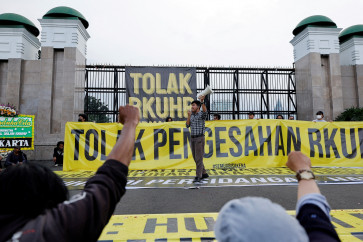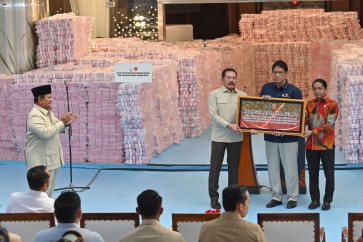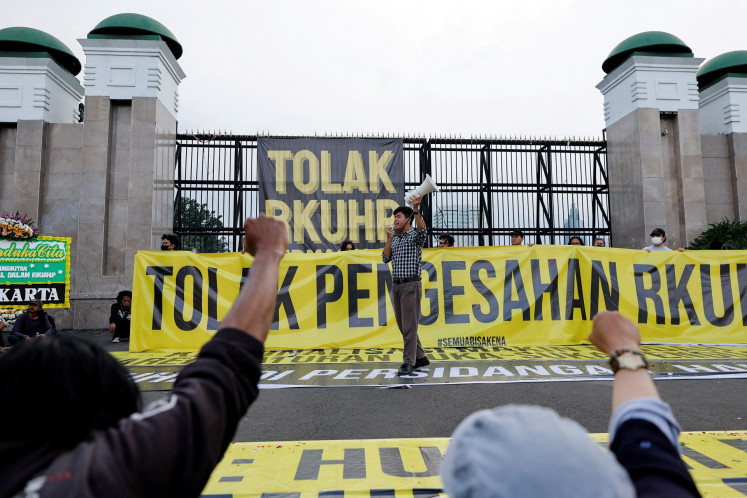Popular Reads
Top Results
Can't find what you're looking for?
View all search resultsPopular Reads
Top Results
Can't find what you're looking for?
View all search resultsMultilateralization of ASEAN
The meeting of ASEAN+3 Finance Ministers (AFMM+3) in Madrid in 2008 made three strategic decisions on the currency swap facility under the Chiang Mai Initiative (CMI)
Change text size
Gift Premium Articles
to Anyone
T
he meeting of ASEAN+3 Finance Ministers (AFMM+3) in Madrid in 2008 made three strategic decisions on the currency swap facility under the Chiang Mai Initiative (CMI).
First, to enlarge the size of the facility from US$36.5 billion in 2001-2005 to $84 billion in May 2008 and to a further $120 billion in 2009. Second, to increase the portion that is non-linked to IMF programs. The third decision has been to multilateralize it.
The CMI was established in May 2000 in Chiang Mai, Thailand, as a bilateral swap arrangement. The CMI is an expansion of the existing ASEAN Swap Arrangement (ASA), a network of bilateral swaps and repurchase arrangement facilities among the five original ASEAN member countries.
The ASA facility also started modestly, which each country originally contributed $40 million until it raised to 1 billion in 2000.
Established by five signatories of the Bangkok Declaration in 1967 (Thailand, Malaysia, Singapore, Indonesia and the Philippines), ASEAN has now 10 member countries after Brunei Darussalam, Cambodia, Laos, Myanmar and Vietnam joined the organization later. The main purpose of ASEAN has been expanded from securing regional political and security stability in the Cold-War era to the promotion of regional trade, investment and monetary cooperation.
The three countries are the People’s Republic of China, Japan and the Republic of Korea. ASEAN has signed the ASEAN Free Trade Area and each of the three countries has an individual Free Trade Agreement (FTA) with ASEAN. Unlike the European Union (EU), ASEAN and ASEAN+3 are not monetary unions.
Multilateralization of the CMI is a great leap forward toward a greater political cohesion in ASEAN+3 countries as with their own initiatives they transfer some national powers to a regional institution. The CMIM is close to a multilateral pooling of financial resources under the failed proposal for establishing an Asian Monetary Fund (AMF).
The AMF proposal was rejected by China, the US and European countries during the Annual Meetings of the IMF in Hong Kong in 1997. The multilateralized CMI will result in the pooled fund becoming self-managed under a single contract, thus reducing costly bilateral transactions and a wasteful duplication of loan contracts. The Chiang Mai Initiative Multilateralization (CMIM) is a quota-based arrangement with quotas allocated in favor of the smaller, less populated and less affluent member countries.
The CMIM is expected to become operational at the end of this year, and to achieve this objective the AFMM+3 has assigned its deputies (AFDM+3) to work out the operational details and implementation plan, including the legal documents that will govern the CMIM.
The decision to reform the CMI came at a particular critical time to supplement the available IMF facilities and other existing international financial arrangements for countries in need. The IMF and the great powers (such as the US, EU and China) are now more ready to accept regional financial cooperation.
The export-oriented ASEAN+3 economies, which benefited from rapid economic growth and large-scale capital inflow during the global upturn, were suffering from the global financial crisis in 2007-2008 as the advanced countries cut back their imports and exposure of their banks. Similar to the earlier turmoil, some ASEAN+3 economies experienced severe disruptions in their currency and asset markets in 2008 due to limited access to external financing and the global shortage of the US dollar.
On May 9 2010, the EU Summit established the European Financial Stability Facility (EFSF) to address the financial crises in the former socialist countries in Eastern Europe from 2008-2009 and current problems in Greece, Portugal, Spain and Ireland.
The EFSF worth up to ¤750 billion and consists of a) an expansion of the existing balance of payment facility and b) a special purpose vehicle consisting of pooled bilateral guarantees from 16 eurozone countries. It is expected that the IMF contributes an additional 50 percent to the EFSF. The use of the EFSF is subject to the IMF conditionality.
In addition, the EFSF and IMF facility, the European Central Bank (ECB), has shifted its role from the guardian of price stability in the eurozone to the lender of the last resort and crisis manager in the area.
Through its Securities Market Program (SMP), the ECB has accepted securities issued or guaranteed by the Greek government, irrespective of the credit rating, as collateral in its credit operations.
Sitting on huge foreign exchange reserves, it is natural for ASEAN+3 to strengthen regional cooperation to provide financial needs. They were dissatisfied with the program conditionality imposed by the IMF during the Asian financial crisis from 1997-1998, which they perceived as being intruding, unfair or wrong. During the recent global financial crisis from 2007-2008, the US Federal Reserve Bank’s currency swap facility was, in October 2008, extended to 14 central banks of high- and medium-income countries.
Of these three are members of ASEAN+3 countries, namely Japan, South Korea and Singapore. The facility eased the global shortage and helped restore market confidence as it augmented external reserves of the recipient countries and allowed them to draw down balances denominated in the US dollar to meet their needs in that currency and stabilize their currencies.
Meanwhile, the less affluent countries in this region have either turned to the ADB, the World Bank, the CMI or donor countries for emergency financial assistance. Because of the stigma attached to the IMF following the Asian financial crisis, no countries in this region have requested financial assistance from the fund.
The writer is a professor of economics at the University of Indonesia. He is former senior deputy governor of Bank Indonesia (central bank) and has a PhD degree in monetary economics from Harvard University.










